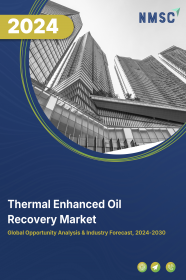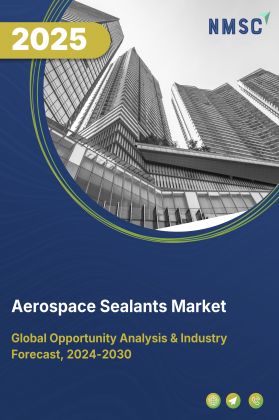
Thermal Enhanced Oil Recovery Market by Technology (Steam Injection, In-Situ Combustion (ISC), Hybrid Methods, Novel Thermal Methods), by Field Location (Onshore, Offshore, Transition Zone)by Reservoir Type (Heavy Oil (API 10-20), Bitumen/Extra-Heavy Oil (API <10), Conventional Oil with Low Mobility), by Project Stage (Greenfield Projects, Brownfield Projects), by Component (Equipment & Systems, and others) - Global Opportunity Analysis and Industry Forecast 2023-2030
Industry: Materials and Chemical | Publish Date: 21-Aug-2025 | No of Pages: 610 | No. of Tables: 409 | No. of Figures: 334 | Format: PDF | Report Code : MC538
Market Definition
The Thermal Enhanced Oil Recovery Market was valued at USD 29.35 billion in 2022 and is predicted to reach USD 55.24 billion by 2030 with a CAGR of 7.60% from 2023-2030. Thermal enhanced oil recovery method is an enhanced oil recovery method (EOR) used in oil fields to extract heavy oils that reduces production levels due to their high viscosity. Thermal EOR method usually involves burning of natural gas to produce steam, which is injected into the reservoir to heat heavy oil to reduce viscosity. This process allows oil to flow more easily through the reservoir and significantly increases the production of the oil field. Thermal enhanced oil recovery methods are widely adopted by energy companies across the world as it reduces energy costs and carbon footprint of the produced crude oil.
Market Dynamics and Trends
Increasing demand of oil and gas across the globe owing to the exponential consumption of oil across different industry verticals such as transportation, shipping, power, manufacturing, and others is driving the thermal enhanced oil recovery market. Petroleum and other liquid fuels are dominant source of transportation energy worldwide. For instance, in 2021, according to the United Nations (UN), the transport sector was responsible for around 57% of the total oil demand across the world.
Also, high adoption of enhanced oil recovery methods (EOR) by oil and gas companies across the world as EOR enables the extraction of immobile oil and reduces the cost of drilling new wells and further enhance production is driving the thermal enhanced oil recovery market. Moreover, rising number of matured or aged oil fields that has reached its peak production and started to decline owing to poor permeability or exhibiting heavy oil is increasing the adoption of EOR methods such as thermal enhanced oil recovery due to its effectiveness, which is further driving the market.
However, factors such as necessity of rigorous R&D activities and highly skilled professionals to adopt these extremely complex oil recovery methods and stepwise implementation that requires high investment are restraining the thermal enhanced oil recovery market.
On the contrary, introduction of solar thermal enhanced oil recovery methods that decreases gas consumption is expected to create ample growth opportunities for the market. It uses solar energy to heat water and generate steam contrary to traditional methods such as gas-fired steams.
Market Segmentations and Scope of the Study
The thermal enhanced oil recovery market is segmented on the basis of technology, application and geography. On the basis of technology, the market is classified into hot water, steam, in-situ combustion (ISC), electrical heating, and electromagnetic heating. The Steam segment is further divided into cyclic steam stimulation (CSS), steam-assisted gravity drainage (SAGD) and steam flooding. The in-situ combustion (ISC) segment is further classified into forward, reverse, and high-pressure air injection (HPAI). The electromagnetic heating segment is further divided into microwave and radio frequency. On the basis of Application, the market is categorized into onshore and offshore. Geographic breakdown and analysis of each of the aforesaid segments includes regions comprising of North America, Europe, Asia-Pacific, and RoW.
Geographical Analysis
North America holds the lion share of thermal enhanced oil recovery market and is expected to dominate the market at the present time. This is attributed to factors such as several initiatives taken by the government in this region to promote the uses of enhanced oil recovery methods in oil & gas industry. For instance, in 2019, The US Department of Energy (DOE) had contributed 40 million US dollar in research and development (R&D) projects designed to reduce technical risks in enhanced oil recovery (EOR) and expand application of EOR methods in conventional and unconventional reservoirs.
Moreover, presence of key market players such as Suncor, ConocoPhillips, Cenovus Energy and Chevron Corporation further boosts the market growth in this region. For instance, in September 2021, Suncor announced that it aims to acquire an equity interest in the Northern Courier Pipeline in Canada. This accusation will help Suncor to generate a gross revenue of approximately 16 million USD annually.
On the other hand, Asia Pacific is expected to show a steady rise in the thermal enhanced oil recovery market owing to the high demand of hydrocarbons as they serve as fuels and lubricants as well as raw materials for the production of fibres, rubbers, solvents, plastics, and industrial chemicals in developing economies with large population such as India and China. For instance, in December 2021, Daqing Oilfield, controlled by the China National Petroleum Corporation (CNOOC), in China's Heilongjiang Province, had become the world's largest enhanced oil recovery production base. The annual crude oil output via enhanced oil recovery of Daqing Oilfield has exceeded 10 million ton for consecutive 20 years, making its cumulative total production to 286 million ton. Moreover, countries in Asia Pacific such as China and India are aiming to reduce the high dependence on crude oil imports by improving production capabilities using EOR methods in their matured oil fields, which is further influencing the growth of the market.
Competitive Landscape
The thermal enhanced oil recovery market is comprising of various market players such as Saudi Arabian Oil Company (Saudi Aramco), China National Petroleum Corporation (CNPC), China Petroleum & Chemical Corporation (Sinopec), Chevron Corporation, Exxon Mobil Corporation, Shell plc, TotalEnergies SE, Canadian Natural Resources Limited (“CNRL”), ConocoPhillips, Cenovus Energy Inc., Suncor Energy Inc., Abu Dhabi National Oil Company (“ADNOC”), Occidental Petroleum Corporation, Imperial Oil Limited, Petroleum Development Oman (PDO), Ecopetrol S.A., Oil and Natural Gas Corporation (ONGC), Kuwait Oil Company (KOC), PT Pertamina (Persero), Gazprom Neft and others. These market players are adopting various joint venture strategies and planning expansion of business across various regions to maintain their dominance in the thermal enhanced oil recovery market.
For Instance, in June 13, 2022, Cenovus Energy announced that it aimed to acquired 50% of the Sunrise oil sands project from BP Plc in Canada for 600 million US dollar. Through this acquisition Cenovus aims to enhance its core strength in the oil sands and further increase production while decreasing operating costs and emissions. Moreover, in January 2021, ConocoPhillips announced that it had completed the acquisition of Concho Resources. This acquisition will help ConocoPhillips to enhance its marker presence and product portfolio globally.
Key Market Segments
By Technology
-
Steam Injection
-
Cyclic Steam Stimulation (CSS)
-
Steam Flooding
-
Steam‑Assisted Gravity Drainage (SAGD)
-
-
In-Situ Combustion (ISC)
-
Forward Combustion
-
Reverse Combustion
-
High‑Pressure Air Injection (HPAI)
-
-
Hybrid Methods
-
Solvent-Assisted Thermal
-
Thermal-Chemical
-
-
Novel Thermal Methods
-
Electromagnetic Heating (RF/MW)
-
Solar-Assisted Steam
-
By Field Location
-
Onshore
-
Offshore
-
Transition Zone
By Reservoir Type
-
Heavy Oil (API 10-20)
-
Bitumen/Extra-Heavy Oil (API <10)
-
Conventional Oil with Low Mobility
By Project Stage
-
Greenfield Projects
-
Brownfield Projects
By Component
-
Equipment & Systems
-
Steam Generation Systems (OTSG, HRSG)
-
Thermal Well Completions
-
Electromagnetic Heating Hardware
-
Solar Thermal Collectors
-
-
Services
-
Reservoir Characterization & Simulation
-
Well Drilling & Completion Services
-
AI/ML Optimization Platforms
-
Water Treatment & Recycling
-
CCUS Integration
-
By End-User
-
National Oil Companies (NOCs)
-
International Oil Companies (IOCs)
-
Independent E&P Companies
-
Oilfield Services Providers
By Region
-
North America
-
U.S.
-
Canada
-
Mexico
-
-
Europe
-
U.K.
-
Germany
-
France
-
Italy
-
Spain
-
Denmark
-
Netherlands
-
Finland
-
Sweden
-
Norway
-
Russia
-
Rest of Europe
-
-
Asia-Pacific
-
China
-
Japan
-
India
-
South Korea
-
Australia
-
Indonesia
-
Singapore
-
Taiwan
-
Thailand
-
Rest of Asia-Pacific
-
-
RoW
-
Latin America
-
Middle East
-
Africa
-
Key Players
-
Saudi Arabian Oil Company (Saudi Aramco)
-
China National Petroleum Corporation (CNPC)
-
China Petroleum & Chemical Corporation (Sinopec)
-
Chevron Corporation
-
Exxon Mobil Corporation
-
Shell plc
-
TotalEnergies SE
-
Canadian Natural Resources Limited (“CNRL”)
-
ConocoPhillips
-
Cenovus Energy Inc.
-
Suncor Energy Inc.
-
Abu Dhabi National Oil Company (“ADNOC”)
-
Occidental Petroleum Corporation
-
Imperial Oil Limited
-
Petroleum Development Oman (PDO)
-
Ecopetrol S.A.
-
Oil and Natural Gas Corporation (ONGC)
-
Kuwait Oil Company (KOC)
-
PT Pertamina (Persero)
-
Gazprom Neft

















 Speak to Our Analyst
Speak to Our Analyst
























